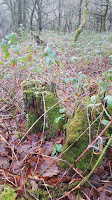Under testing weather conditions (poor doesn't come close) and frequently muttering to ourselves 'what are we doing here???', we spent yesterday afternoon recording in the Sitka plantation on Mynydd Ton. On a fine day you could sit and admire the views of the Rhondda and Ogwr valleys, but yesterday the biting wind brought tears to your eyes. The plantation provided a welcome shelter.
The target tetrad (SS99M) had only 22 bryophyte records before we set out, but we managed to bring it up to a modest 55 after a couple of hours. Surprisingly, we couldn't find any
Colura but the Sitka plantation here is relatively young and a bit isolated from the nearest forests in the Rhondda and Gwynfi valleys which do. Highlights were a local patch of
Loeskeobryum brevirostre and stretches of forest tracks with nice mixtures of liverworts that included
Aneura pinguis,
Leiocolea badensis,
Jungermannia spp. and
Preissia quadrata. We've not seen
P. quadrata in forestry before, so this was a nice addition to the forest track list.
The most abundant
Jungermannia species was dark green, pleasnatly scented and decked with abundant perianths.
I couldn't find any male plants, so I hesitate in saying that these plants are dioecious. However, there aren't any obvious male structures on the leaves (or bracts) below the perianth, so they don't appear to be paroecious - the arrows in the two lower photos point to the upper pair of leaves/bracts below the female bracts. The perianths don't have an obvious beak at their apex like those of
J. pumila, but resemble those of
J. atrovirens, which is known to colonise forest tracks in Ireland and Wales. Please comment.
There was also a large population of
Huperzia selago in the heathy verge along the track and in another RCT plantation to the north-east we recently recorded a massive population of
Lycopodium clavatum. It's a joy to see these clubmosses doing so well in these forestry habitats.
This tetrad contains some nice rock outcrops and a bit of urban habitat that we haven't yet looked at, so there's more to be added.





















































